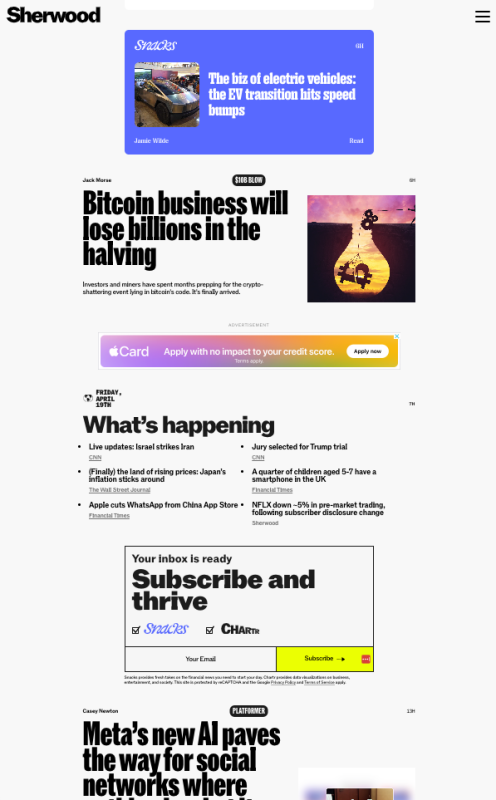
Sherwood News, the US-based business news outlet launched this month by retail trading platform Robinhood, is betting that ad-supported, un-paywalled news can turn a profit in the internet’s post-scale era.
The publication says it aims to report “actionable, illuminating news on the markets, business, tech and the culture of money”. Typical stories have included reports on Bitcoin’s long-predicted value “halving”, so-called litigation investment and the business of cryogenics.
Robinhood’s core service is an app that allows users to easily trade stocks, something which brought it to wider attention during the retail trading boom of the early Covid era and the widely-publicised growth in meme stocks.
And although Sherwood News is written with Robinhood users in mind, the publication’s editor-in-chief and president, Verge co-founder Joshua Topolsky, told Press Gazette that it had a broader eye on “an entire spectrum of younger, very savvy, very online audiences that are very interested in how money moves in the world”.
Modern internet habits ‘don’t look like the front page of The New York Times’
In an Axios write-up of Sherwood’s launch, reporter Sara Fischer compared the new outlet to Bloomberg Media, which grew out of an information service for the finance industry (and which Topolsky used to work at as chief digital officer).
Asked about the comparison, Topolsky said he thought the audience around which Robinhood had built its business did not yet have a news source suited for its needs “and I think that’s Sherwood’s opportunity”.
Sherwood’s front page looks somewhat like a social media feed: as a reader scrolls down they move further back in time, passing by a mix of original Sherwood News stories and articles aggregated from elsewhere.

“Our express purpose in building it this way was to create an infinite scroll experience that is whatever the opposite of doom scrolling would be,” Topolsky said. “We’re trying to initiate that feeling in people, which is: what feels natural on a mobile device?”
He added: “When you look at what the habits are of a modern user of the internet, it doesn’t look like the front page of The New York Times and it doesn’t look like Bloomberg and it doesn’t look like The Wall Street Journal.”
The front page is largely free of references to parent company Robinhood. Although Sherwood is open about its affiliation with the trading platform, Topolsky said its goal was to be profitable in its own right, not to act as a funnel for the app.
He explained that although Sherwood does not directly promote Robinhood, “there’s obviously a philosophical marriage in telling the story of what’s going on in the markets every day – and in business, and in tech – in a way that makes sense for this audience”.
Making a stand for free, ad-funded news
Sherwood News is not Robinhood’s first foray into publishing: in 2019 the platform bought financial newsletter Marketsnacks – now just called Snacks – which reportedly had 40 million subscribers by April 2022.
Snacks is now integrated into Sherwood, which Topolsky told Axios employs approximately 36 people. The team is centred on New York City, he told Press Gazette, with some based out of California and a cluster working in London on data storytelling outlet Chartr, which Robinhood bought in December.
Sherwood is currently monetised mostly through direct-sold advertising. Advertisers visible during a Press Gazette visit to the site last week included Apple, Nasdaq, a mortgage broker and a firm inviting customers to “invest in AI that disrupts influencer marketing”.
Topolsky said Sherwood has no plans to introduce a paywall.
“The catchphrase here is to democratise finance for all, and honestly, I’m not a big Kool-Aid drinker or anything, but I really do believe the founders of this business really did have this idea that they wanted to make investing more accessible for more people.
“And one thing I will say is, I have always believed in the idea of ad-supported media as being a vehicle to let everyone see the stories that you want to tell, and let everyone have access to great information. And I think, done well, ad-supported media can be incredibly powerful.”
He added: “So far it’s been working very well in terms of us finding partners that really want to get in front of this audience and speak to them. We’ve done it in a way, and are doing it in a way, that tries to be unobtrusive and commensurate with the type of content that we’re doing…
“Down the road you never know, but that is the business model that makes a lot of sense to all of us – to make this available to everybody who can get online, basically.”
Mass-market, advertising-funded news outlets have been turning to other revenue streams recently as both referral traffic and yields on programmatic advertising have declined.
Major news start-up The Messenger folded in January after less than a year in business, last April Buzzfeed News shuttered and Vice mothballed its website in February. Among still-extant businesses, mass-market behemoths Mail Online and Reach have both begun trialling partial paywalls, and arguably the most successful consumer media brand in the world at present is the paywalled New York Times.
But Topolsky was bullish on Sherwood’s approach, saying: “Advertising is an enormous business for Facebook. It’s an enormous business for Google. It’s the business that most free services that people use on the internet [are] centred around.
“I believe that, in a world where people believe infinite scale is possible, and every news site tries to do the same thing as every other one, and the belief is that massive scale is the answer to all of the problems – I think that’s a space that’s going to be declining, because I don’t believe that that’s actually how human beings come to interact with stories or with brands.
“I think that they want specific and real things, and I think that increasingly, when you’ve got this sea of sameness and sea of vagueness and, frankly, sea of mis- and dis-information all over the place, I think they’re looking more and more for specific, understandable sources. I think there’s lots of upside for an ad-supported business when you can be that, and that’s what we strive to be.”
Topolsky said he felt the media had been “a bit abusive to audiences” over the past decade.
“Social media provided this idea that massive scale was always going to be attainable, that there was an infinite number of eyeballs and infinite amount of audience for whatever you did and the more you could make of something, the more there’d be people there for it.
“And that just watered down and sort of diminished so much of what news the news industry should be doing. And so I think a move away from that can only be, in many ways, a positive thing for a lot of the industry.”
Asked how much runway he thought Sherwood News has to prove itself to its parent business, Topolsky said that “we are a contributing part of the business”.
He would not be drawn on whether that meant the publication was already generating more revenue than it cost to run, but he said his “cynical view” was that “we contribute actual money into the business, so as long as we can do that in a positive manner, I feel like we have plenty of runway”.
From a more philosophical standpoint, he said: “We’re in the media business so you never know, but I really believe that the leadership of the business is very invested in this idea of giving people better information and better news about what is going on in this world so they can be a more empowered and effective investor.
“You can imagine all of the different types of upside it might have for a business like this… It’s media, you know, but I like our chances, let’s put it that way.”
Email pged@pressgazette.co.uk to point out mistakes, provide story tips or send in a letter for publication on our "Letters Page" blog
